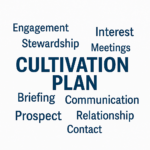Key Components to Include in a Cultivation Plan

Successful major gift fundraising is rarely spontaneous. It is the result of a well-researched, meticulously crafted, and consistently executed cultivation plan. For philanthropy officers, creating and following a thoughtful cultivation plan is essential to move prospects through the donor pipeline—from identification to solicitation and stewardship. Here are the key components every philanthropy officer should include in a cultivation plan to maximise engagement and giving potential.
1. Prospect Profile
Start with a comprehensive profile that includes:
- Biographical information: Age, profession, family details, affiliations
- Giving history: Past gifts to your organisation and others
- Wealth indicators: Estimated capacity, assets, publicly available financial info
- Affinities and interests: What causes matter to them?
- Connections: Who do they know within your organisation or network?
This sets the stage for informed and strategic engagement.
2. Cultivation Goals
Define what success looks like for this particular prospect. Is it:
- Securing an initial face-to-face meeting?
- Inviting them to join a giving circle or attend an event?
- Moving them to the solicitation stage for a specific gift?
Setting specific, measurable objectives helps guide your strategy.
3. Engagement Timeline
Lay out a realistic 3- to 12-month timeline with key touchpoints. These might include:
- Personal meetings
- Event invitations
- Mission-based experiences (e.g. program site visits)
- Phone calls or handwritten notes
- Impact updates or insider briefings
Stagger interactions to avoid overwhelming the prospect while maintaining consistent contact.
4. Team Roles and Responsibilities
Determine who is best positioned to build rapport. It may not always be the philanthropy officer. Include:
- CEO or Executive Director
- Board member
- Program staff
- Peer donor or ambassador
List who will engage the prospect at each step and what their role is.
5. Key Messages and Talking Points
Tailor your messaging around:
- Organisational mission and impact
- Specific programs aligned with the prospect’s interests
- Case for support, including outcomes and needs
Ensure the messaging resonates with the prospect’s values and philanthropic motivations.
6. Engagement Methods
Consider a mix of touchpoints, including:
- Email updates or newsletters
- Phone check-ins
- Personalised video messages
- Invitations to donor briefings, tours, or cultivation events
Use varied formats to deepen the relationship and keep the communication fresh.
7. Prospect Feedback and Intelligence
Document responses and insights gained through each interaction:
- What excited them?
- What concerns were raised?
- Any hints about timing, giving interest, or decision-making process?
This qualitative intelligence informs your next move and strengthens your ask later on.
8. Readiness Assessment
Periodically assess whether the prospect is showing signs of readiness:
- Are they asking specific questions about funding needs?
- Have they attended multiple events or engaged deeply?
- Are they responsive and open to ongoing dialogue?
When readiness indicators are met, begin preparing for the solicitation phase.
9. Next Steps and Tactics
Always know what comes next. After every interaction, outline:
- The follow-up action
- Who is responsible
- When it will happen
This keeps the cultivation plan active rather than passive.
10. CRM and Documentation
Log all actions, notes, and insights in your CRM. Accurate, up-to-date documentation:
- Maintains continuity across staff
- Allows for reporting and forecasting
- Supports transition in case of staff turnover
Avoid keeping plans “in your head” or in private spreadsheets. Transparency and consistency are key.
Cultivating major gift prospects is both an art and a science. A well-crafted cultivation plan is a dynamic tool—adaptable, strategic, and personalised. For philanthropy officers, the goal is not just to manage a relationship but to meaningfully connect a donor’s values to your organisation’s mission. With these key components in place, you can confidently build trust, inspire generosity, and ultimately secure transformational support.
